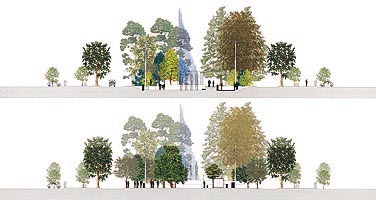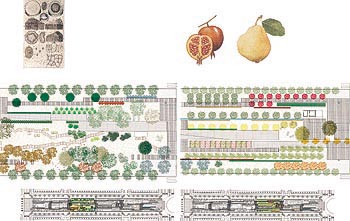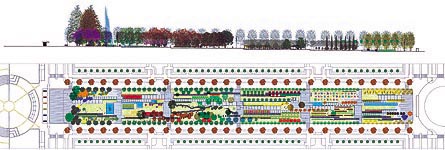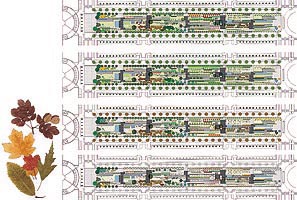The garden of senses

Primer Premio/First
Prize
Arquitectos/Architects:
Miguel del Rey, Iñigo Magro, Antonio Gallud
| Jardín de los
sentidos The garden of senses |
 |
Concurso de Proyectos para la urbanización del Boulevard Central del Campus de "Riu Sec". Universidad Jaume I. Castellón |
|
Primer Premio/First
Prize |
Ideas competition for the Central Boulevard of the "Riu Sec" Campus, Jaume I University, Castellón, Spain |
| B. EL
OLFATO. PLANTAS AROMÁTICAS En esta zona estarán representadas las plantas aromáticas y medicinales más comunes en el territorio castellonense, pudiendo tener aquí la condición de colecciones representativas de los montes cercanos. El esquema de plantación se basa en una cuadrícula donde queden debidamente catalogadas, alternando con naranjos ornamentales pequeños que den consistencia al conjunto y aporten el aroma de su azahar. Al otro lado del camino, una rosaleda nos dará además de su aroma, una variedad cromática que compensará la humildad de las flores de las aromáticas. En paralelo, unos setos de hoja perenne (boj, mirto, pittosporum), lograrán diferentes verdes aromáticos aún en invierno cuando los rosales estén desnudos. Una línea central de naranjos amargos y elevado porte, por su doble condición de flor aromática y frutal, nos conducirá al siguiente jardín, enlazando el olfato con el gusto. C. EL GUSTO. ÁRBOLES FRUTALES El emparrado toma la forma de una pérgola con vides comestibles y ornamentales (parra virgen) para que la gama de colorido otoñal sea más intensa y prolongada. Una plaza con dos moreras, árboles de sombra y fruto, y junto a ella un kiosco o "zumería" en donde el gusto encuentra los mayores placeres naturales. El olivo nos conectará el gusto indudable de su fruto con la textura de sus troncos retorcidos, y nos introducirá en el jardín del tacto. D. EL TACTO. BOSQUE MEDITERRÁNEO El sentido del tacto se potenciará con una muestra de troncos de árboles cortados en secciones distintas que nos hagan participes de las diferentes texturas al tacto de las maderas y de las cortezas en varias familias botánicas. También con una serie de piedras de canteras cercanas donde al tacto, podamos apreciar tanto el lugar exacto de su procedencia grabado en ellas, como los diferentes acabados que se puede dar a una piedra. E. EL OIDO. VEGETACIÓN Y AGUA EN
MOVIMIENTO F. LA VISTA. CONTRASTES DE FORMAS
Y COLORES La vista podrá ir cambiando de coloridos en mayo, con los contrastes intencionados de la Grevillea en flor, color amarillo azafrán con la azul-lila de las Jacarandas, que coinciden en el tiempo de floración pero raramente se pueden contemplar juntas. En Diciembre, el amarillo intenso de las hojas del Ginkgo antes de la caída contrasta fuertemente con el verde de los pinos, cedros y cipreses, ofreciéndonos uno de los espectáculos de color más llamativos que podemos encontrar en el invierno. El agua, que nos llega desde el tramo anterior, se convierte aquí en un gran surtidor que constituye el centro focal de todo el jardín. La explanada central, y los laterales bajo las copas de los árboles, serán lugares agradables de descanso y encuentro en cualquier época del año. |
B.
SMELL. HERBS The most common medicinal and aromatic herbs of the Castellón region are gathered together in this zone, forming collections that represent the nearby hills and mountains. The planting scheme is based on a grid where the herbs (duly labelled) alternate with small ornamental orange trees that give substance to the ensemble and contribute the perfume of their blossoms. On the other side of the path, a rose garden perfumes the air and also provides a chromatic variety that compensates for the humble flowers of the herbs. Parallel to this, evergreen hedges (box, myrtle, pittosporum) achieve a variety of aromatic greens even in winter when the roses are bare. A central line of tall bitter orange trees not only have aromatic flowers but also bear fruit, and therefore act as the link between smell and taste, leading us to the following garden. C. TASTE. FRUIT TREES The arbour is a pergola with ornamental (Virginia creeper) and fruit vines that prolong and intensify the colour range in autumn. A square with two mulberry trees, which give both shade and fruit, has a refreshments stand or fruit juice bar so that the best natural tastes can be enjoyed. The olive tree combines the unquestionable taste of its fruits with the texture of its twisted trunk, leading to the garden of touch. D. TOUCH. MEDITERRANEAN WOODS The sense of touch is enhanced by a sample of tree trunks cut into different sections to give a feel of the differing textures of the wood and bark of various botanical families. On a series of stones from nearby quarries, not only can their exact place of origin, carved into them, be discovered by touch but also the different types of finish that can be applied to stone. E. HEARING. MOVING VEGETATION AND WATER F. SIGHT. CONTRASTING FORMS AND COLOURS The sight of the colours changes in May with the intentional contrast between the saffron yellow flowers of the Grevillea and the lilac-blue of the Jacarandas. They flower at the same time but can seldom be seen together. In December, the deep yellow of the Gingko leaves before they fall is in sharp contrast to the green of the pines, cedars and cypresses, providing one of the most striking colour spectacles that it is possible to find in winter. The water which enters from the previous section becomes a great jet that provides the focal point for the entire garden. The central esplanade and the sides under the canopy of the trees will be pleasant places to rest and meet people at all times of the year. |

|
Ingeniero T. Agrícola / Agricultural
Technical Engineer: Arquitectos colaboradores / Collaborating
architects: |
 |
 |